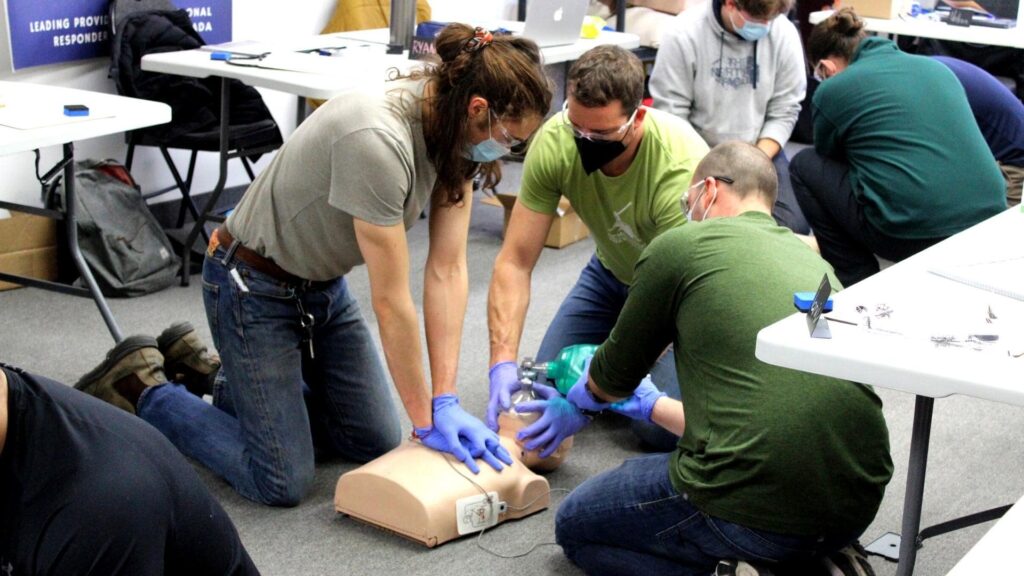The increasing number of people diagnosed with cardiac health issues means millions are at risk of heart attacks and cardiac arrest. Since most of these occur outside of a hospital, Basic Life Support provides the training to help increase survival rates, particularly for cardiac arrest victims who would otherwise have minimal recovery and survival chances without help.
On completion of the higher level CPR training, participants have more than just the life-saving skills required; they also have the confidence to carry out the steps at any given time.
Remember: Basic Life Support was formerly known as HCP. In 2019, the training requirements changed from one hour to four-hour training to cover more information. The information covered during the training prepares participants by providing them with training in a broader range of topics and all the necessary skills to save a life. The course is based on the most updated knowledge and adapted to the Canadian requirements for patient care. Read ahead to get a head start if you are wondering, “How do I get a Basic Life Support Certification?”
What is Basic Life Support Certification
Basic Life Support (BLS) training provides advanced cardiopulmonary resuscitation (CPR) training for professional responders working in a team environment. The training follows particular guidelines to help participants learn the critical steps required to perform BLS when the patient isn’t in a hospital setting.
During the training, participants learn to do a rapid assessment of the patient, perform chest compressions, ventilations (rescue breaths), and rapid defibrillation, and use an Automated External Defibrillator (AED).
Participants often opt to take the extra training of the Airway Management and Oxygen Therapy course to get the additional certification.
Learn about Basic Life Support Course you might need
Certify for Basic Life Support to assist someone with your life-saving skills as you complete the course with us. Call our toll-free number to know more.
What Professions Require BLS Certification
Several professionals require BLS certification, including pre-hospital care providers like those working in the rescue services as first responders, firefighters, lifeguards, ski patrols, and sports medicine professionals.
Additionally, in-facility providers like nursing staff, medical and dental professionals, and caregivers also require BLS certification.
Scholars in any of the above professional fields also require BLS training.

What are the Course Prerequisites
During the 4 hours required to complete the course, participants earn the theory of BLS and practice the hands-on skills before receiving their WSIB-approved certification. There are no specific requirements for the training unless you are doing the recertification, in which case you must bring your valid BLS certificate to class. However, 100% attendance is required.
Basic Life Support certification remains valid for one year after participants demonstrate their skill competency and pass the closed book evaluation with a minimum of 75%. The recertification training also takes 4 hours, but you must update courses before the certification expires.
What is the Course Content?
Preparing to help others requires that you know how to recognize various incidents, including heart attacks, strokes, cardiac arrests, allergic shocks, etc. The training includes understanding how to activate an early emergency response system and to respond decisively by performing the necessary CPR or treatment as a single rescuer or part of a rescue team.
During the four-hour Basic Life Support training course, you can expect to learn the following:
- Basic Life Support Introduction
- Correct glove removal procedures
- Performing a primary assessment
- Everything about cardiopulmonary resuscitation (CPR), including giving chest compressions to infants, children, and adults
- Using an AED correctly
- How to correctly perform chest compressions
- Dealing with airway obstruction, including choking
- Executing assisted ventilation or “rescue breaths with mouth-to-mouth resuscitation or with a bag valve mask
- Handling trauma
- Treating patients suffering from anaphylaxis, hypothermia, and overdoses
- Post-cardiac arrest care
- All the special Basic Life Support considerations
- Six Rights of Medication
Furthermore, you learn about working in a team environment and the importance of maintaining team communication and debriefing when handing a patient over.

Find Training Near Me
Coast2Coast, the Canadian Red Cross training partner, provides the Ontario WSIB-approved Basic Life Support training across Greater Toronto, Western Ontario, and Eastern Ontario at several locations.
For your convenience, you can opt to do the course in any of the three daily slots available at most centers in the province. Therefore, depending on whether you prefer morning, afternoon, or evening, you can get BLS certification at the time that suits you best.
With BLS, you can offer support in the workplace and in your community. Whether you work in a fast-paced hospital environment or elsewhere, your certification is valid across all Canadian provinces.
You can view upcoming courses in your area based on your convenience and take advantage of Coast2Coast’s ongoing promotions here. With BLS training, you are always prepared to respond to an emergency, ensuring patients in out-of-hospital situations have a better chance of survival!



















